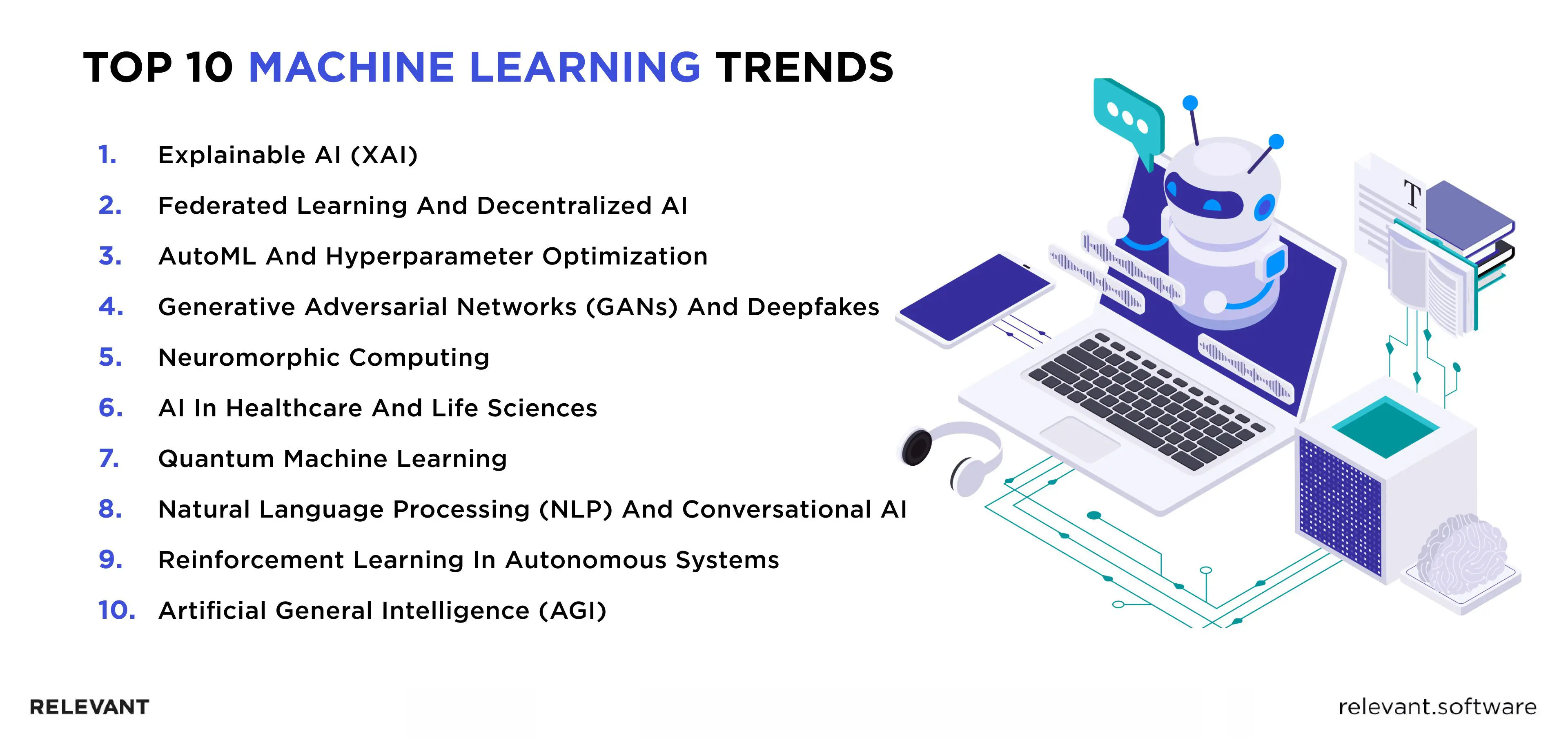How is the Future of Machine Learning Shaping Up?

On the way to the future of machine learning, we’ve moved past the stage of cautious steps and onto a path of rapid, confident strides. Look around, and you’ll see that the influence of AI and machine learning is everywhere, from the meticulous personalization of your digital experiences to streamlined, data-driven business decisions that were once the domain of gut feelings and guesstimates.
We’re seeing a comprehensive reimagining of what it means to use computing to improve all sectors. It’s about actionable insights in business, breakthroughs in diagnosing illnesses, and conserving the planet we call home. It’s not just about “smart” machines; it’s about insightful, adaptable systems that learn and evolve.
Our discussion here is grounded in reality, in the practical and the already-possible. Let’s strip away the techno-babble and gaze clearly at trends in machine learning 2024. This article is not about fantastic predictions; it examines the key factors that will redefine innovation mechanisms in the near future.
Key Milestones in Machine Learning’s Rich History
Let’s dial back the clock and casually stroll through machine learning’s hallmarks.
- Back in 1943, Warren McCulloch and Walter Pitts brainstormed in a room full of bulky computers. They planted the seeds of machine learning by crafting a model that mimicked how neurons fire in the brain. No one at the time could’ve guessed where the future applications of machine learning would lead.
- Fast forward to 1950, and there’s Alan Turing — a name you’ve likely heard — posing a simple question: Can machines think? He threw down the gauntlet with his Turing Test, daring anyone to build a machine indistinguishable from a human in conversation. It was a bold idea that fuels debates and dreams in AI circles today.
- Arthur Samuel, in 1952, broke new ground by programming a computer to refine its checker-playing strategy, effectively learning from its experiences.
- A pivotal moment occurred in 1957 when Frank Rosenblatt built the Perceptron, the pioneer neural network, laying the groundwork for modern ML architectures.
- The year 1967 saw the advent of the “nearest neighbor” algorithm, which empowered computers with rudimentary pattern recognition capabilities.
- Fast forward to 1979, when Stanford students engineered the ‘Stanford Cart,’ capable of autonomously navigating through obstructions.
- Gerald Dejong, in 1981, put forth the concept of Explanation Based Learning (EBL), which enabled computers to extract general principles from data while ignoring extraneous information.
- 1997 was a landmark year when IBM’s Deep Blue harnessed ML to dethrone the reigning world chess champion.
- Geoffrey Hinton, in 2006, introduced “deep learning” to describe algorithms that allow computers to identify objects and text in images and videos, much like the human brain.
- In 2010, Microsoft’s Kinect leaped by tracking human features in real time, facilitating a new level of interaction between people and computers through movement and gestures.
- Google made strides in 2011 with Google Brain, developing a deep neural network with object recognition capabilities comparable to a cat’s.
- Facebook, in 2014, released DeepFace, an algorithmic marvel capable of identifying and authenticating individuals in photos with a precision matching that of humans.
- In 2017, Waymo started to test autonomous vehicles on American roads and introduced its fully self-driving taxi service in Phoenix, Arizona, later that year.
- Most recently, in 2022, OpenAI launched ChatGPT, an AI chatbot adept at generating conversational text that closely resembles human writing based on input prompts.
Your next read: OpenAI ChatGPT
Current State of Machine Learning
The machine intelligence and machine learning industry is currently valued at $14.1 billion. Grand View Research, Inc. forecasts that by 2030, the worldwide artificial intelligence market could expand to $1,811.75 Billion, signifying an enormous potential for business growth and industrial transformation.
In the healthcare sector, for example, machine learning models are deployed to sift through vast datasets, identifying patterns that aid in early disease detection and personalized treatment plans. Financial institutions harness these algorithms to detect fraudulent activity by pinpointing anomalies that deviate from established transaction patterns. In the automotive industry, machine learning is the driving force behind the latest advances in autonomous vehicles, processing real-time data to make split-second decisions on the road.
At the core of these applications is a significant advancement in algorithms’ ability to learn from data without being explicitly programmed for every contingency. Deep learning, a subset of machine learning mimicking the human brain’s neural networks, has been pivotal in processing and making sense of large volumes of unstructured data — be it text, sound, or images.
Another remarkable development is the accessibility of machine learning. With cloud computing resources becoming more affordable and widespread, what was once the domain of tech giants is now within reach for startups and mid-sized enterprises. This democratization means that machine learning is now integrated into the fabric of software solutions across the market spectrum.

Key Drivers of Change in Machine Learning
Today’s machine learning landscape displays practical, robust technology being leveraged across industries to solve complex problems. Unlike its earlier years, machine learning is no longer an esoteric discipline understood and discussed only within academic corridors or tech incubators. It has rapidly matured into a critical modern business strategy and operations component.
- Hardware Advances: Think of the latest machine learning hardware like a sports car on a racetrack — it’s all about speed and performance. New processors specifically designed for AI tasks are making these algorithms faster and more efficient. And while quantum computing isn’t a part of our everyday life yet, it’s on the horizon, ready to redefine what’s possible.
- Richer Data Resources: Nowadays, data flow comes from every corner — social media, sensors, and smartphones. This isn’t just more data; it’s better, more insightful data teaching AI systems how to make smarter decisions, much like an experienced human would.
- Algorithmic Breakthroughs: Algorithms are the brains of the operation, and they’re getting smarter. Techniques like deep learning enable computers to learn big data to recognize patterns and make predictions with an accuracy that was hard to imagine just a few years ago.
- Ethical Imperatives: Greater power comes with great responsibility. As AI plays a bigger role in our lives, ensuring it’s fair, understandable, and respects our privacy is as important as technology. It’s about keeping the human element at the heart of AI.
Exploring the Top 10 Influential Machine Learning Trends
The prospects for machine learning are vast and varied. Machine learning’s applications extend across numerous standard fields, making it simpler to envision its expansive potential. Let’s look at the foundations and trends in machine learning that come into play.

1. Explainable AI (XAI)
Explainable AI is one of the machine learning trends that demystify the decisions made by complex algorithms, particularly where the stakes are high, like in healthcare diagnostics or financial forecasting. Imagine having a guide who translates the intricate language of AI into clear reasoning.
That’s what techniques like LIME (Local Interpretable Model-Agnostic Explanations) and SHAP (SHapley Additive exPlanations) do — they don’t just reveal what AI is thinking but how it’s thinking. LIME breaks down the decision-making process around specific use cases, and SHAP quantifies the impact of each data feature. It’s about making AI decisions transparent, understandable, and accountable — ensuring we meet the stringent demands of regulations like GDPR.
2. Federated Learning and Decentralized AI
The surge in IoT (Internet of Things) and connected devices provides a rich vein of data for machine learning, yet it poses significant privacy and security concerns. Federated learning presents a viable solution by decentralizing the model training process.
This approach preserves privacy and taps into the collaborative strength of multiple devices, each contributing to a collective model improvement without exchanging raw data. Such distributed learning is pivotal for sectors like healthcare and finance and allows for the collaborative creation of robust diagnostics or financial forecasting models while upholding data privacy standards.
3. AutoML and Hyperparameter Optimization
AutoML simplifies the creation of machine learning models, making high-quality ML accessible to non-experts. It automates the tedious process of model selection and hyperparameter tuning, often hindering effective ML development.
Hyperparameter optimization is the fine-tuning that improves model performance. It’s a critical step to adjusting a high-performance engine for peak efficiency. The right settings can differentiate between a mediocre and highly accurate model.
By using AutoML, we can bypass months of manual adjustment. It navigates through potential configurations methodically, finding optimal settings faster than any human could. That isn’t cutting corners; it’s leveraging machine learning technology to focus human expertise where it’s needed most — on problem-solving and strategy.
4. Generative Adversarial Networks (GANs) and Deepfakes
Generative Adversarial Networks, or GANs, stand at the forefront of machine learning trends that synthesize strikingly authentic visuals. Picture a tool so adept that it generates images nearly indistinguishable from actual photographs, serving sectors that need to work with sensitive or non-existent data — such as simulating medical imagery for research without compromising patient privacy.
But let’s get real: they’re also the tech behind deepfakes. It’s like walking a tightrope; on one side, with generative AI tools, you’ve got incredible potential for innovation, and on the other, a minefield of ethical dilemmas. If you’re using this tech, it’s about striking a balance — harnessing their power for good while fighting against the darker side of deepfakes. It’s all about being smart and staying on the right side of the ethical line in the future of machine learning 2024.
5. Neuromorphic Computing
Neuromorphic computing is kind of like engineering’s nod to the brilliance of the human brain. Instead of the usual computer setup where tasks are tackled one after the other, neuromorphic systems are all about multitasking — just like our gray matter does. They use a network very similar to our neurons and synapses, which means they can quickly and ultra-efficiently process information.
So, what does one of the cutting-edge trends in machine learning 2024 look like in the real world? Well, it’s like having a security system that doesn’t just follow a script — it gets the gist of what’s going on and can flag anything odd on the fly. This isn’t about brute force computing power; it’s about finesse and intuition, the kind that’s been exclusive to living, breathing creatures… until now.
6. AI in Healthcare and Life Sciences
Now, let’s look at the healthcare sector. Machine learning dives into a pool of medical data and extracts information that could easily slip through the cracks, ensuring patients receive quick and accurate diagnoses. It’s tailoring treatment plans for each individual like never before. For those behind the scenes in research? Machine learning is the ultimate partner, tirelessly poring over data to uncover the next medical breakthroughs. That isn’t just about technology’s future – it’s about its present, transforming how we approach health and medicine at a speed that was once wishful thinking.
7. Quantum Machine Learning
Quantum machine learning is essentially a powerhouse combination, merging the speed of quantum computing with the adaptability of machine learning. Picture a vast library of information that traditional computers would take centuries to sift through. Now, imagine a quantum computer tackling this in mere hours or even minutes.
Using principles like superposition — where a quantum bit, or qubit, can be both a 1 and a 0 at the same time — and entanglement, which links qubits across distances so they act in unison, quantum machines can analyze data in a way that’s just not possible today. For industries with complex problems, like designing new materials or developing new drugs, this could be the key to unlocking answers that we, at present, can hardly fathom. It’s a thrilling peek into future machine-learning trends where our data-crunching capabilities could grow exponentially.

8. Natural Language Processing (NLP) and Conversational AI
NLP is the wizardry that allows machines to decipher our words, turning casual chats with your smartphone or home assistant from mere novelties into genuinely useful interactions. It’s a field that’s constantly learning from our languages, slang, and idioms, making tech more approachable and user-friendly. This isn’t just about programming a computer to recognize speech but teaching it to understand the nuances and subtleties of human communication.
Conversational AI is evolving into a sophisticated colleague rather than a simple software tool. It’s now an entity that not only grasps what you’re saying but also senses the unsaid emotions in your words. It adapts, sometimes with a light-hearted quip to ease the tension, reshaping customer service interactions from dreaded to unexpectedly smooth conversations.
9. Reinforcement Learning in Autonomous Systems
Switching to the realm of autonomy, Reinforcement Learning (RL) is where machines essentially learn from their own “life experiences.” They make choices, face the consequences, and adjust their approach just as we do. This trial-and-error process isn’t just about falling down and getting up; it’s a deliberate practice that makes perfect.
With each iteration, these systems grow more adept, moving closer to a future where machines operate with a degree of independence that mimics human intuition. This blend of learning and doing is subtly shifting the paradigm of autonomous technologies, making them not just functional but also perceptive.
10. Artificial General Intelligence (AGI)
AGI is essentially about building machines that think like humans, capable of tackling any task we can. Getting there is tough — it’s a blend of machine learning, brain science, and computer wizardry. No one’s sure when we’ll crack it; guesses range wildly from a few decades to a hundred years. If we do get AGI right, it could solve some of our trickiest problems, but it’s not without its risks. It’s all about smarter algorithms, beefier computers, and a better grasp of our own brains. And as this tech inches forward, we’ll have to keep a tight rein to ensure it’s ethical and safe.
Final Words
What is the future of AI and machine learning? This technology will be more sophisticated, helping us do more than we ever thought possible. With the smart integration of these systems, the future of robotic process automation and machine learning looks astonishing.
However, in machine learning, the margin between current players and leaders is defined by who leverages new machine learning trends and who doesn’t. That’s the moment for AI engineers from Relevant to engage. Our machine learning & AI development services are your backstage pass to the forefront of AI and ML innovation. We’re here to help you implement these advancements, making sure you’re not just ready for the next big thing but that you’re defining it. Let’s take this leap into the machine learning and future of technology together — your expertise, our AI and ML know-how. It’s a winning combo.



